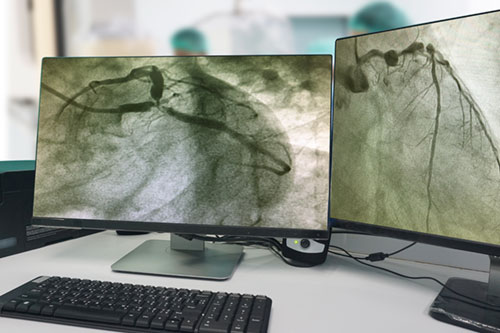What is an Angiogram?
A coronary angiogram is a diagnostic procedure which helps in identifying blocks in the arteries which supply oxygenated blood to the heart muscle.
The heart is the organ which supplies oxygenated blood throughout the body for energy. For its own functioning, there are two main blood vessels that supply blood which are called coronary arteries.
There are two main coronary arteries: left (LMCA) and right (RCA). LMCA has two main branches, left anterior descending (LAD) and left circumflex (LCX). They in turn have many small branches.

What is a Heart Attack?
When blood flow in one or more of the coronary arteries is blocked, most commonly due to a blood clot, the area of the heart muscle where the blood supply is cut begins to die and becomes functionless. This is termed as a heart attack. If we find the culprit and relieve the block with medications or interventions in time, we can prevent cardiac death.
What Are the Basic Tests to Diagnose a Heart Attack?
Any patient complaining of constricting type of chest pain associated with excessive sweating, faintness and breathlessness should be suspected of heart attack. The best basic test is ECG. When a heart attack happens, the electrical impulses generated by the nerves in the heart also get distorted which produces some typical patterns in ECG. Hence, ECG is advised for all patients with the above symptoms. Next, an ECHO will help in determining if there are any problems with the contractility of the heart.
However, to determine which blood vessel is blocked and to find the intensity of the block, coronary angiogram is the gold standard test.
How it is done
A small hollow tube called catheter is passed either through the hand or groin of the patient and reaches the heart and cannulates the coronary artery. This is done under live x-ray guidance. A dye which can be seen through an x-ray is then injected and the filling of the coronary arteries is observed under an x-ray. Any area where the dye is under filled or blocked is the site of the block. Multiple angles of x-ray are needed to completely assess the percentage of the block.
The patient is generally awake during the procedure and sedation is reserved for patients with severe pain and anxiety. Unlike surgery, this is a minimally invasive procedure.
If done by hand, the patient can be discharged the same day; if through the groin, the patient is advised to stay in the hospital for at least one night.
Who Requires a Coronary Angiogram?
- All patients with chest pain and typical ECG findings of a heart attack need an emergency angiogram.
- Patients with risk factors like diabetes, hypertension, etc. who complain of chest pain on exertion will benefit from the test.
- Patients with intermediated or high predictive risk factor who are treadmill test positive.
- Patients with risk factors who are planned for cardiac or major non-cardiac surgery.
How does it help?
This test helps in planning the line of management like deciding whether stent placement or bypass grafting, etc.
Who cannot undergo the test?
As such, there is no absolute contraindication of the test. However, patients with kidney failure are at risk and should be carefully selected as the dye injected can worsen the kidney functions. However, the newer generation of contrast dyes have marginally helped in preventing this.
Patients with a history of severe allergic reaction to contrast dye should not undergo the procedure.
Take Home Message
A coronary angiogram is a diagnostic test to determine block in the arteries supplying the heart muscle. It is a safe, percutaneous, minimally invasive procedure usually done without sedation and can be done as a day-care procedure. It is a test which can determine and help in managing a life-threatening condition, namely heart attack.

Dr. Arun
Senior Resident in Cardiology
Kauvery Hospital Chennai
